As a marketer or small business owner, you’re likely familiar with the challenge of turning abstract ideas into concrete plans. That’s where a well-written creative brief comes into play. It’s more than a mere document—it’s a roadmap for your creative projects that guides your team, aligns your vision, and sets clear expectations for your clients.
But what should a creative brief include and how do you create one that clearly communicates your desired output? We’re sharing all that and more in this article!
Table of contents
What is a creative brief?
A creative brief is a concise document that outlines the key elements and objectives of a marketing project or campaign. It serves as a centralized location to communicate all the necessary details in 1-2 pages.
Typically, a creative brief takes the form of a document, whether it’s a Google doc or a .pdf file. However, it can also be a sheet or a table within a project management tool.
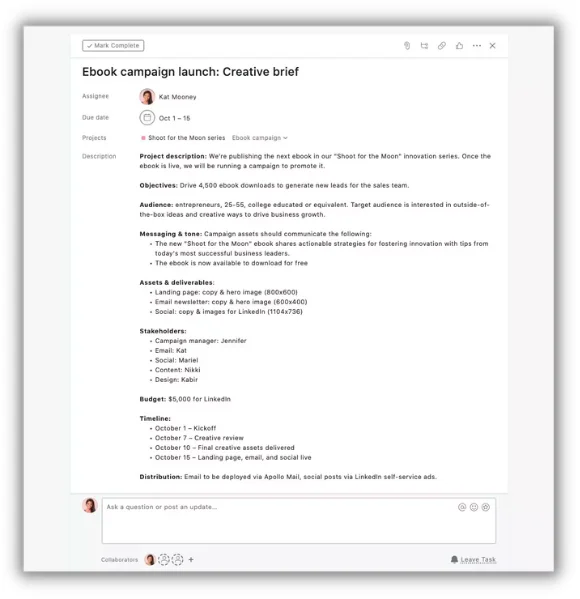
Example of a creative brief in Asana.
Keep in mind that your brief isn’t a place for draft copy or sketching out ad graphics. It shouldn’t be a collaborative, working document because its purpose is to record the crucial details that everyone involved in a project has agreed to.
When do you need a creative brief?
You need a creative brief for any marketing project that requires developing creative elements and coordination between multiple stakeholders. If you’re a marketing team of one whose boss doesn’t want to oversee social content? You don’t need a creative brief for the holiday content you’re putting together yourself. But if you’re a marketing team of one who is working with an agency to create and manage a holiday social campaign? You’re going to want a creative brief.
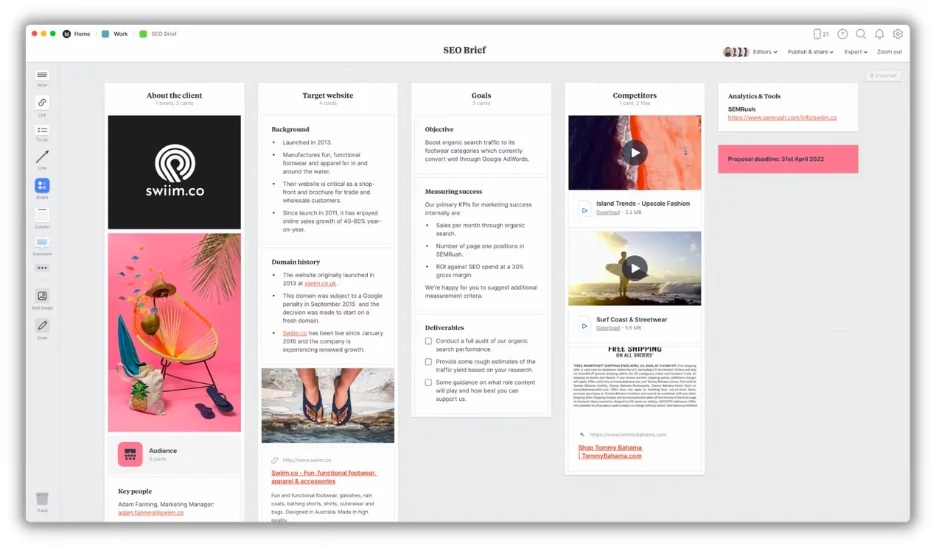
This creative brief example is for an SEO blog post.
Here are a few common types of marketing creative that might require a creative brief:
- Graphic design: Logos, brochures, business cards, brand materials.
- Ad campaigns: Concepts, copy, graphics, media.
- Website and UX design: Full site overhaul, individual pages, event product interfaces.
- Content creation: Blogs, articles, social media posts, and social series.
- Videography: Video content, animations, motion graphics, event videography.
- Photography: Headshots, brand images, product photos, event photography.
- Product packaging: Labels, boxes, containers, shipping materials.
This is a good overview, but it’s not an exhaustive list. If you need to align multiple people on a project, a creative brief is going to be a good idea—and here’s why.
Why use a creative brief?
You should use a creative brief to align all stakeholders on a marketing project or campaign. A brief that includes all essential elements—background essentials, creative direction, and follow-through plans—will help avoid re-doing designs or scrapping a blog post. That means saving time and money spent on any given initiative.
It’s no surprise then that Monday.com found that 93% of marketers use a creative brief of some form to capture and communicate information for their projects.
Even though the overwhelming majority of marketers surveyed used creative briefs, most weren’t satisfied. In fact, 67% reported that they found their briefs completely or partially ineffective.
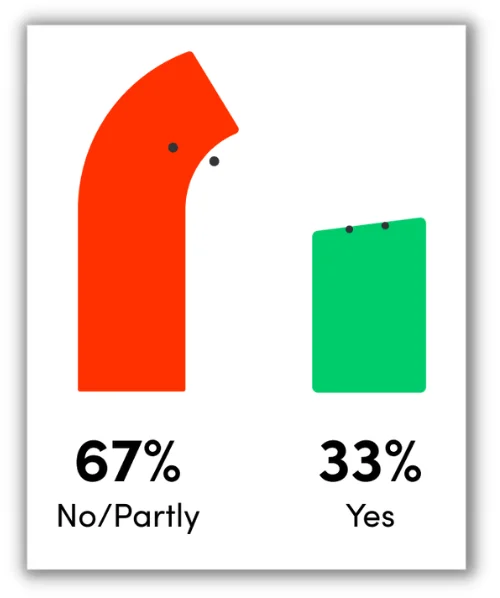
If you’re going to spend time drawing up a document like this for your projects, then it should be effective. Here’s how to write up a successful creative brief—one that leads to better outcomes for your projects and less stress getting there.
How to write a creative brief
Here’s a step-by-step guide to writing your creative brief.
1. Write a project overview
The first thing you need in a creative brief is an overview of the project to identify what you’re looking for, for what purpose, and how that will be completed and finalized.
Outlining these will avoid scope creep, which is the gradual expansion of a project’s original deliverables or requirements. If you’ve ever freelanced, you’re probably all too familiar. This happens when a client adds additional tasks, requests additional features, or increases expectations after the project’s already started. Often, all this ends up as uncompensated work.
This isn’t only bad for contractors, though. When you increase the scope of the project, it often takes more time to complete and needs more communication to review and approve.
Having a quick, clear overview of the project will help avoid scope creep and time delays so that you can keep on track and meet your goals.
2. Define the project objectives
You need objectives for all your marketing activities, and that includes creative campaigns.
Take this example creative brief for PayPal below.
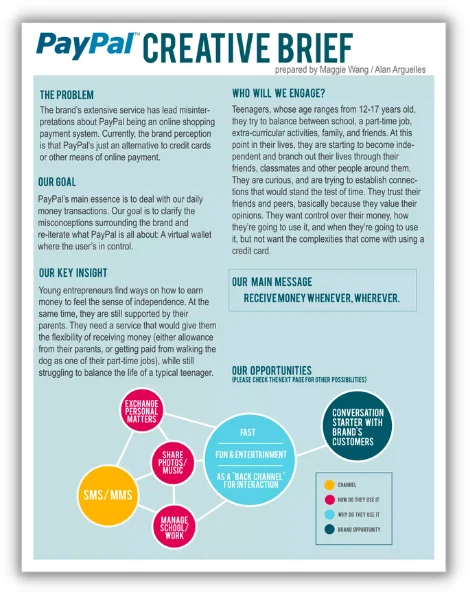
Source
The objective is stated nicely: The point of the campaign is to clear up misunderstandings about what PayPal does and make its offering super clear.
Now, in a perfect world, the specific misconceptions would be written out here. But this is still a good example of an objective for a campaign. What are you trying to do with the creative? Make sure this is what’s communicated to everyone involved in the project.
3. Share your brand’s key messaging and facts
You’ll also need to include your main message or messages that you’re trying to communicate with this marketing collateral.
Say you’re working with a freelancer who is writing copy for Google Ads about your latest product offering. What’s the value proposition of your product? What’s the tagline? What’s the positioning statement? Share your messaging essentials in your creative brief.
While this is especially important for any creative using copy, it’s still useful guidance for visuals. It never hurts to know how best to communicate with your audience—which brings us to the next element of a successful creative brief.
You’ll also need to include some facts that can be used to guide your project. These could be stats, information about your brand, or insight into your audience.
4. Describe your target audience
Understanding your brand’s target audience is the key to developing compelling creative assets.
So include relevant details about your target audience. This will include basic demographic information, like age ranges, gender identities, or occupations. But it should also include more insight into your audience’s connection to your company. Why do they connect with your branding?
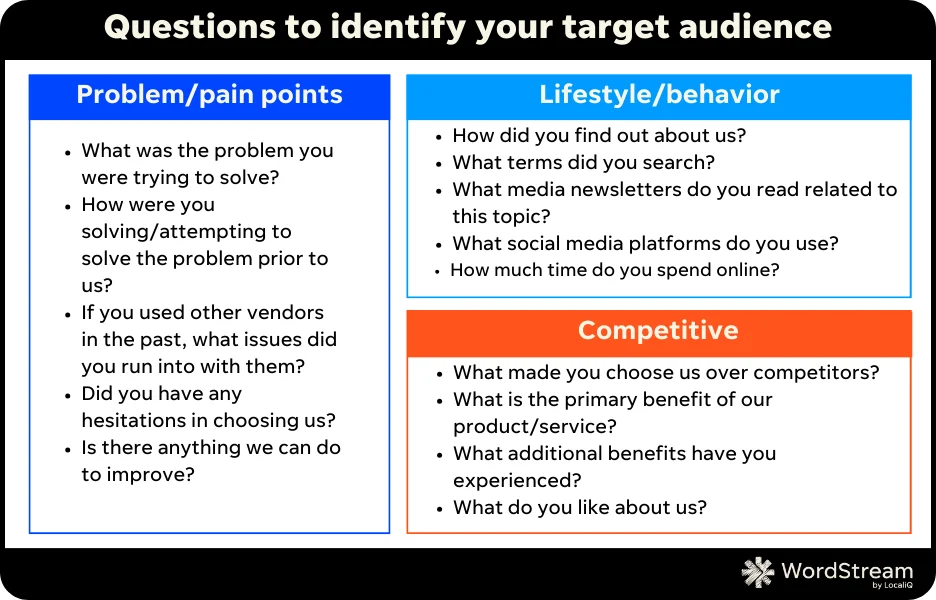
If your creative partner knows the pain points that your customers experience and what motivates them to buy your solution or service, they can use this to make the designs, content, or media more personal. And personalized marketing is effective.
5. Summarize your brand guidelines
When you’re working with someone outside of your organization—or even simply outside of the marketing team—you should include guidelines for your brand.
The other relevant brand information for this will depend on the project. For graphics, for example, this will include your colors, themes, logos, and any design rules. For content, this will include your brand voice and tone standards or your content style guide.
Masooma Memon, a freelance content marketer who writes the great Content Workshop newsletter, recommends keeping this background short and sweet. Instead of sharing a big document, link to a quick one-pager with big dos and don’ts. No one is going to be able to internalize a thick document for a single freelance project, but they are likely to go through a one-pager to make sure everything’s in order.
6. Point out your competitors
In your creative brief, you’ll want to include key competitors. You don’t need to include in-depth competitive analysis in your project document. But you do want to include relevant competitor information.
For example, let’s say you manage marketing for a doggy daycare and there’s only one other option in town. If you’re looking for new brand visuals, you want to make sure that your colors, style, and overall creative feel are super distinguishable from your major local competitor.
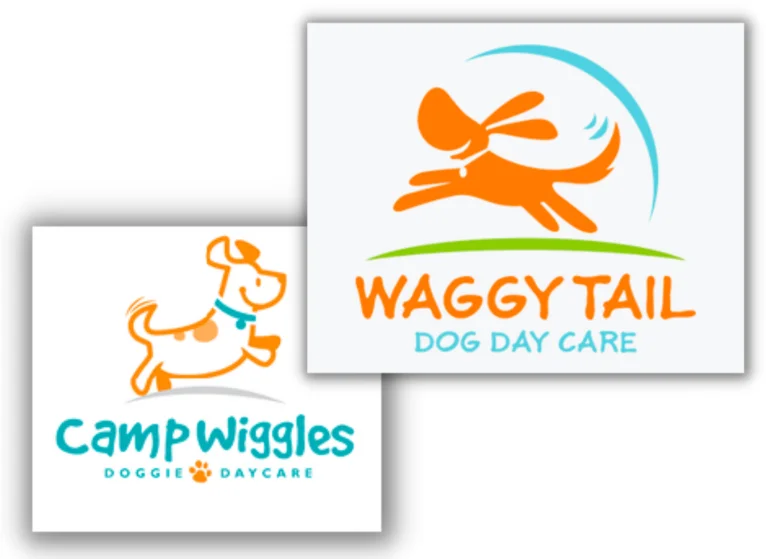
If you ended up with logos this close to your competition because you didn’t include it in the creative brief, you’d be in trouble.
7. Include any references for inspiration
Let’s start with a caveat: Your creative brief should include more information about your business and your products than your competitors. But if you’ve got examples of amazing creative from other companies that you’re looking to for inspiration, include that.
The best examples to use will be from businesses that aren’t your competitors. You never want to copy, but
Take this creative from dog food company Stella & Chewy’s campaign below. This photo could be a great reference visual for photos highlighting dog leashes, pet-friendly hotels, or even hiking shoes.

8. Spell out the timeline and deliverables
Your creative brief is different from your contract, which you should have as an agreement with any agency or freelancer you’re working with. It’s your contract that will cover payment terms and timelines, as well as other aspects of the agreement such as rights, non-disclosure agreements, and more.
But your creative brief should include an overview of the specific deliverables you’re looking for and the exact deliverables you’re expecting to receive.
Let’s say you’re looking for a new logo, you need to specify what file types you’ll need—like .svgs, .pngs, and more—as well as any versions—like black and white, color, reversed, favicon. Those additional logos may not require additional designs, but they do require additional work. Your designer needs to be aware.
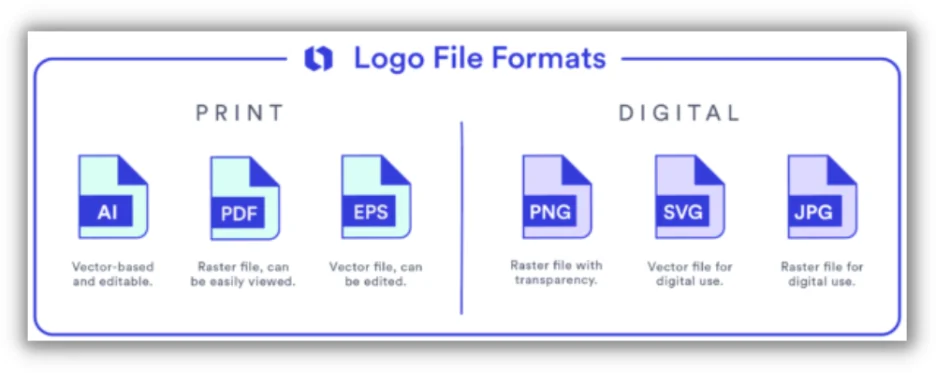
Source
It’s also worth confirming the delivery method. Videographers, for instance, might require you to provide a hard drive for physical delivery or specify ahead of time if you need a digital file transfer. If you have a bigger project, those files will be huge. Plus, you’ll need to agree on how many rounds of edits will be included and the turnaround time for these.
So stick a list reviewing the agreed-upon deadlines, the deliverables, and the method of delivery in your creative brief to cover your bases.
9. State your distribution plan
Context matters, and it should have a quick spot in your creative brief. Whether you’ve got someone writing a blog post or putting together graphics for a campaign, it’s good for the creator to have an idea of where their project fits in your marketing.
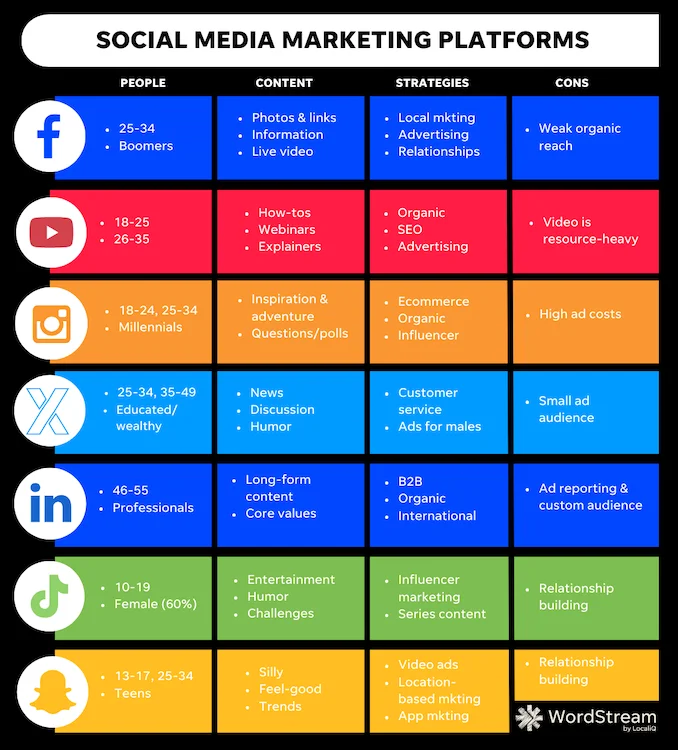
Social media assets are great examples for considering this. You can use graphics and copy across platforms, but you’ll want to tailor it slightly for the different personalities of each platform. On Facebook groups and family updates are the big draw. Images are secondary on Twitter. Photos are most polished on Instagram. LinkedIn loves a long-winded post.
Knowing the social media platform you’re planning to use for distribution won’t necessarily change the scope of your project. But it will make sure your designer is aware of the types of content you’re competing with for user attention. That’s helpful information.
Creative brief examples
Need some inspiration before you write your own creative brief? Here are a few to help guide you!
Colgate creative brief
This creative brief from Colgate is simple, yet effective.
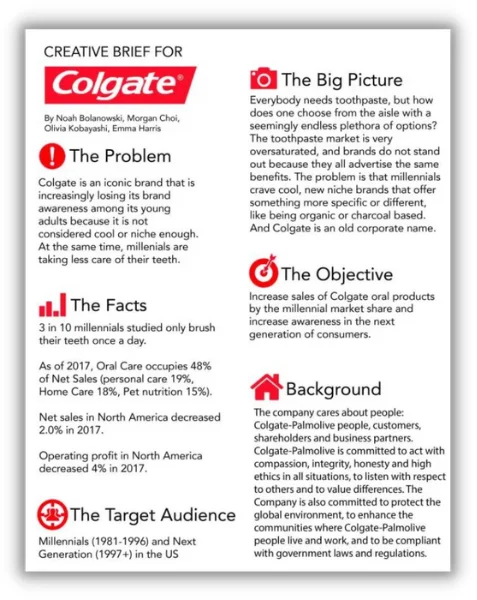
They clearly lay out the information needed to get started on their project. And they keep it simple, yet on brand, with some Colgate-red icons.
Nike creative brief
Nike has excellent branding, so it stands to reason that their creative brief would be excellent as well.
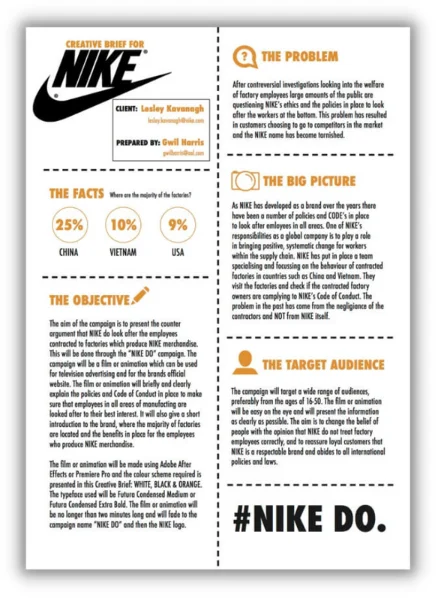
They clearly lay out their facts, objective, problem, the big picture, and their target audience to help guide their project.
LocaliQ creative brief
Here’s an example of a creative brief the LocaliQ team uses for internal projects.

It includes all the necessary information needed to create final deliverables that can include presentations, guides, ads, and more.
Creative brief template
Here’s a simple creative brief template to help you get started. Make a copy and get to work!
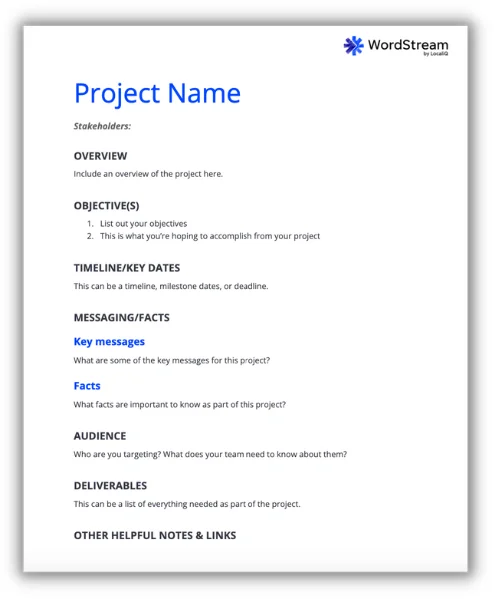
Make a copy
Make your creative briefs count
This might seem like a lot of information, but remember that each of these steps shouldn’t take more than a paragraph. Your creative briefs should be compact—short and sweet documents that contain everything you need to know about a marketing project in process in just a few pages.
Here’s how to write a creative brief in 9 simple steps:
- Write a project overview
- Define the project objectives
- Share your brand’s key message and facts
- Describe your target market
- Summarize your brand guidelines
- Point out your competitors
- Include any references for inspiration
- Spell out the timeline and deliverables
- State your distribution plan
Follow these steps for less back-and-forth with your team and fewer creative revisions—and more time to focus on how to put your amazing creative to use.



